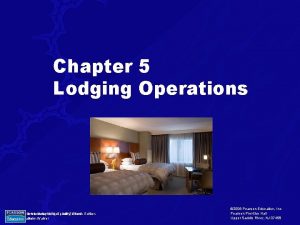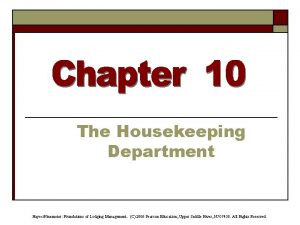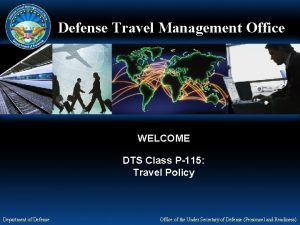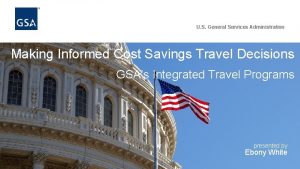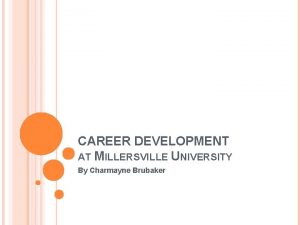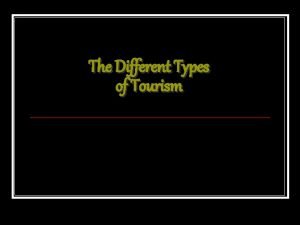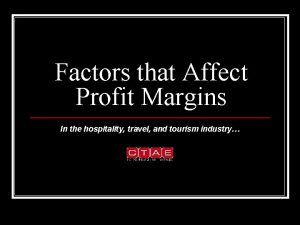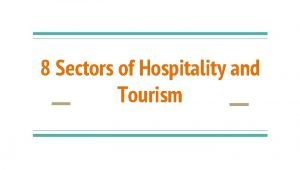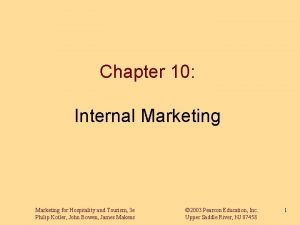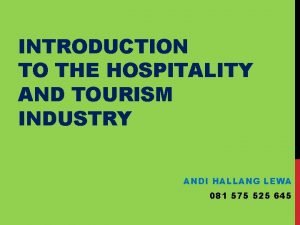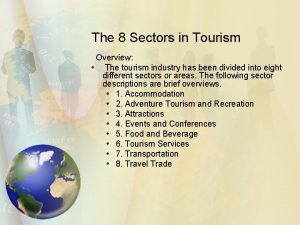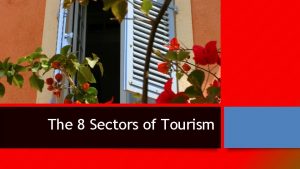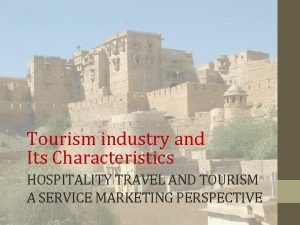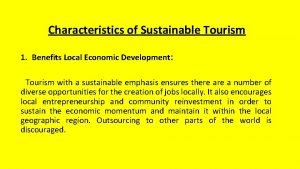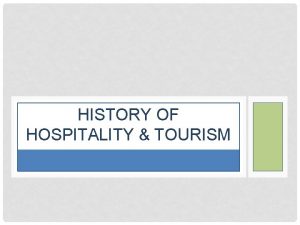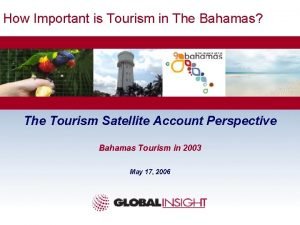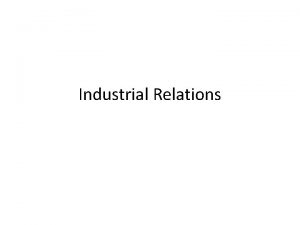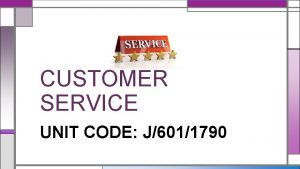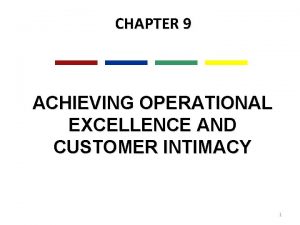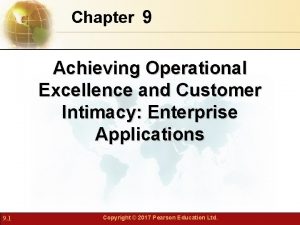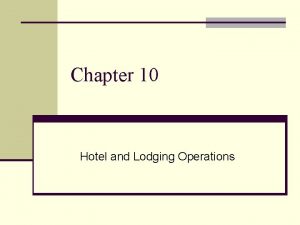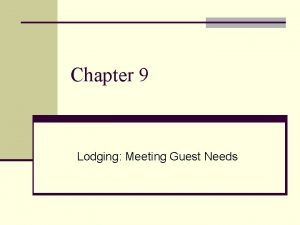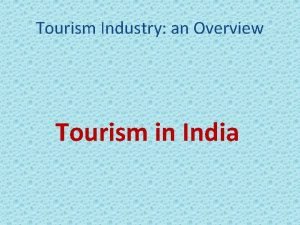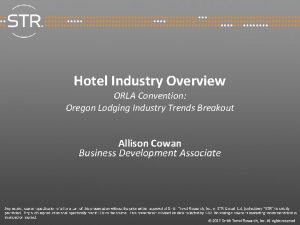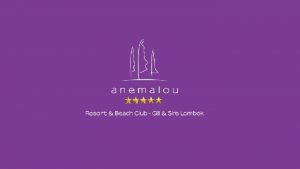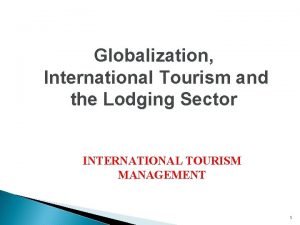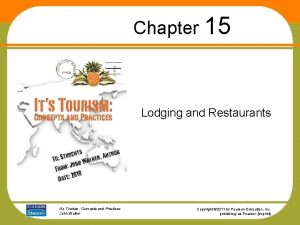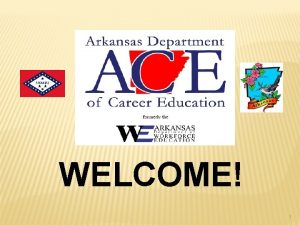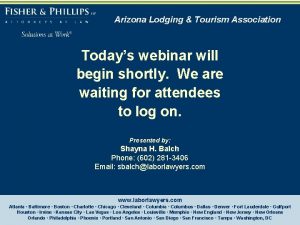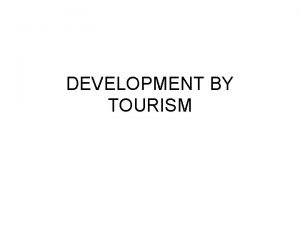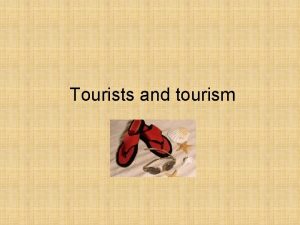SUCCESSFUL CUSTOMER RELATIONS THE LODGING INDUSTRY THE TOURISM



































- Slides: 35

SUCCESSFUL CUSTOMER RELATIONS THE LODGING INDUSTRY THE TOURISM & RETAIL INDUSTRY


Today’s patrons of food service, as well as lodging, tourism, travel, and retail industries have high expectations. They expect their service providers to be pleasant, helpful, and friendly. Greet customers with a smile; fulfill all requests without appearing annoyed; sincerely thank the customer; work cooperatively with co-workers to meet the needs of the customers.

Customers want to be served at THEIR own pace, so timing in the foodservice industry is a key factor to success. Customers of full-service operations (especially more expensive ones) usually prefer to dine in a leisurely fashion. Carefully ‘time’ when to take an order, bring out another course, offer beverage refills or dessert, or bring the check. Customers of quick-service operations should be greeted and served as quickly as possible. Customers arriving just before closing deserve the same service as earlier guests.

Whether you are the host, waiter/waitress, manager, busboy, or chef… you need to present yourself in a manner that makes a good first impression. • Practice good hygiene • No strong fragrances • Clean and groomed hands and nails • Hair should be clean and held back or up • Dress appropriately in clean, wrinkle-free clothing or uniform • Do not drink, eat, smoke, or chew gum in sight of customers

Maintain your focus on the customer Say ‘hello’ and ‘thank you and goodbye’ to every customer Never say ‘no’ to a customer; honor the request OR suggest an acceptable alternative Demonstrate a sense of ‘urgency’, responding immediately to customer questions, requests, and complaints. Anticipate the customer’s needs and accommodate them BEFORE being asked.

Employees who work together and help each other have less stress on the job, happier customers, and high levels of job satisfaction. Be aware of co-workers needs, and work as a team to meet customer needs when necessary. A good food service worker won’t be afraid to do a job outside of their usual job description.

Customers with disabilities may need ample seating space for crutches, walkers or wheelchairs. Many elderly customers may need more time, explanations about the menu, or assistance in reading the menu or carrying food to a table A snack before the entrée, a box of crayons and paper, booster seats and high chairs, and knowledge of the children’s menu helps families with children. Know the ingredients in every menu item in order to assist customers with allergies.

Good communication with customers must be positive and polite. Speak well, in complete sentences, and without slang. Do not speak too fast; listen. Use positive non-verbal communication such as facial expressions, tone of voice, or posture. Avoid inappropriate topics such as your personal life. Describe menu items verbally and nonverbally in a manner and with terms that are appetizing. Feel free to make a recommendation.

Policies and rules of a food service establishment ensure safety, protect the establishment legally, and protect the ultimate goal: repeat customers and profit. Most food service operations have policies regarding the ‘comping’ of a full meal, or any part of a meal. ‘Comping’ means ‘not charging for’, and is sometimes the best way to deal with disgruntled customers in order to assure their satisfaction. Know the rules of the operation, and how to apply them. If a customer complains about a rule that cannot be changed, be ready to suggest another solution. Managers usually have the authority to comp drinks, a dessert, or even a whole meal when appropriate.

Each contact a customer makes with an employee of a food service establishment is called a ‘service encounter’. Those service encounters will influence the customer’s attitude about the entire operation. Back-of-the-house employees serve their ‘internal customers’ or co-workers, but do not usually have direct contact with the paying customers. Dishwashers, cooks, and maintenance personnel are in this category. Front-of-the-house employees are those that make direct customer contact, such as the server, host/hostess, and bus-people.

Studies show that the most important factor in the customer’s mind when choosing a restaurant is the quality of service provided. 80% of customers who do not return to an operation cite their unhappiness with employee attitudes…not bad food. Because competition in the food service industry is so fierce, losing even one customer can have a serious impact. Only about 4% of dissatisfied customers let the management know they are unhappy, but each one of those customers tells an average of 10 other people about their bad experience. It costs 5 times more to advertise and attract new guests than it does to keep current ones. It is important that word-of-mouth advertising be positive.

A good customer service plan, developed by the manager, is a wellthought out and systematic plan for handling customer service. The plan must: identify problems and their causes, set short-term (from 1 day to 1 year) and long-term (2 -5 years) goals, develop a mission statement for the operation, assess human and material resources available for the operation, implement their plans by communicating with and training employees, and monitor results.

Soliciting customer feedback can help monitor how well the service plan is working. Feedback can be gained through the use of quick surveys called ‘comment cards’ left on the table, through the hiring of mystery shoppers who visit and report on their experiences, or via comments from panels of customers called focus groups. Some establishments use a variety of service guarantees to put the customer in control: ‘If your lunch is not delivered to your table within 20 minutes, your next lunch is free!” OR “Did your waitress ask you if you wanted dessert before she brought the bill? If not, ask for your free piece of pie!” A service guarantee is one of the last steps in the customer service planning process.


As far back as stagecoaches were stopping at rest stops, The lodging industry has always been the idea of providing lodging properties (temporary housing strongly influenced by changes in to overnight guests for a transportation and to the economy. As price) has grown. early as the 1700’s American inns combined food and beverage services with lodging, and hotels, motels, suites, resorts, and bed & breakfasts popped up in tourist and business locations, and near railway and shipping hubs. People traveled when the economy was good (and lodging operations flourished), and stayed home when the economy was depressed (many hotels closed during the Great Depression of the 1930’s). The 1940’s brought World War II travel. During the 1950’s lodging grew up along highways due to increased car transportation, and near access to airlines.

Administrative Department: The hotelier (ō'təl-yā); manager or owner), managers (including the general manager or GM), and assistant mangers who serve as liaisons between the GM and staff; accounting and financial management (controllers and night auditors), human resources staff (recruit, hire, train, and evaluate personnel; develops employee benefit program), marketing and sales (includes convention managers and advertising specialists)

Service Department: Front office (desk clerks greet, check in and out, take reservations), bell captain (oversees bellhops, valet parking), housekeeping/room attendants, engineering and maintenance (energy usage), food & beverage, concierge (kahn-see-AIRJE; info and customer services) and security A second language would give an employee a competitive edge in international lodging operations.

The focus of the lodging property is on the type of customers they cater to during the week or on weekends. Leisure travelers want to ‘get away from it all’, and enjoy activities for children, health facilities, pools, shopping, sightseeing opportunities, relaxation, etc. Business travelers need access to office equipment (computers, fax, copiers), meeting rooms, banquet facilities The #1 factor considered when choosing lodging is ‘cleanliness’.

Lodging properties are classified according to the level of service provided, rates charged, amenities offered, or a combination of these. The American Automobile Association (AAA) and Mobile Travel Guides provide consumers with rating scales of lodging properties. Types of properties include: economy, mid -priced, full-service, luxury, all-suite, Amenities are services or facilities meeting/ convention, within a lodging operation that guests resort, use without leaving the premises. and bed & breakfast.

The PMS monitors ‘room inventory’ (total number of rooms available for rent), and status. Available rooms are ‘open’; reserved rooms are ‘blocked’, and include ‘confirmed’ reservations (those being held until a certain time); ‘guaranteed’ rooms (those that are prepaid); and rooms under ‘repair’ (not available due to maintenance). Property management systems (PMS) are computer software programs designed for the lodging industry. An account set up for each guest allows departments throughout the facility to ‘post’ charges on that account (i. e. meals, dry cleaning, telephone calls). A statement of all charges and payments is called the ‘guest folio’. A central reservation system (CRS) links availability of rooms in all chain properties nationwide.

A ‘rooms forecast’ allows facility managers to project revenues, manage finances, schedule labor, and order supplies. General managers use ‘yield management’ strategies to change room rates as demand varies, to overbook reservations (reserve more rooms than are available), and deal with ‘no shows’ (guests never arrive) or ‘understays’ (guests cut expected stays short). Guests may be quoted the ‘rack rate’ for a room (the highest rate), or be given discounted rates such as: ‘corporate or business’ ‘government’ ‘educational’ ‘family’ ‘weekly rates’ ‘airline or agent’ ‘complimentary’ (free promotion)

The Hubbart formula helps managers set rates using 4 main factors: operating expenses, the desired return on investment (ROI), other income (such as that from food and beverage departments), and projected room sales. (Operating expenses + desired ROI) – other income ______________________ = Room rate Projected room sales Example: ( $3, 000 + $2, 000) $300, 000 operations desired profit other income _________________________ = $47 $100, 000 projected room sales


The tourism industry is a combination of ALL services people require when they are away from home, for any length of time. It includes all businesses that provide service and hospitality to people who spend money while traveling, including transportation, lodging, eating establishments, shops, and entertainment. Cultural and historic tourists want to live among and learn about people from other cultures. Environmental tourists visit places to enjoy natural beauty. Recreational tourists look for places they can swim, lie in the sun, play golf or tennis, see shows, or gamble. Business tourists attend conventions, meetings, and seminars.

Conventions are gatherings of people who have something in common, such as members of an organization or those who share a hobby. Recreation and entertainment: state and national parks, camp sites, shopping areas, theme parks, theatrical performances, and sports events. Expositions are large, public shows of products or services, such as auto shows or garden shows. Trade shows are restricted to those involved in a specific industry, and feature producers or manufacturers who come to advertise and demonstrate their products. Depending on the size of the event, convention, exposition, or trade show, the positive impact on the local economy may be considerable. Guests eat in the restaurants, shop in the stores, and use lodging.

State and national parks (including the well known Yellowstone, Glacier, Sequoia, Everglades, Yosemite, and Grand Canyon) offer natural wonders, plant and animal life, skiing, hiking, boating, fishing, swimming, and camping. A wide variety of facilities and services are available to these tourists, including hotels and restaurants. Primitive camping is for those who wish to ‘rough it’, without electricity or running water. Transient camping is done in areas with access to electricity and bathroom facilities. Vacation camping is for people who intend to stay for longer periods of time, and often want recreational activities and retail shopping.

Malls (enclosed structures designed to accommodate many stores under one roof), outdoor malls (many stores situated in close proximity that often resembles a small village), and discount outlets have become major destinations for travelers. These tourists value the socialization, relaxation, and/or bargain aspects of shopping. Shoppers utilize the restaurants, movie theatres, banks, and video arcades commonly found in malls.

Man-made amusement parks featuring rides, fun houses, and snack foods have been replaced with modern theme parks such as Sea. World, Disney World, Universal Studios, and Busch Gardens. All hospitality industries in the vicinity of theme parks benefit, including transportation, lodging, and food service providers.

The World Health Organization (WHO) determines the types of vaccinations required to enter specific countries. Unlike domestic travel, international travel usually requires a passport, a document verifying name, a photo, date and place of birth, and country of citizenship. Some countries require a visa, a country’s written permission allowing a traveler to enter a country for a specific reason for a specific amount of time. Travelers may need to purchase traveler’s checks from their bank OR use credit cards OR use currency exchanges. Travel involving long flights often takes people across one or more time zones, and can result in jet lag (feelings of extreme fatigue which results in difficulty waking and sleeping).

Travel by airline is the fastest mode of transportation, but is usually the most expensive. Some people are afraid to fly, and others cannot fly into their final destination due to the location of the airport. Traveling by car, whether owned or rented, allows the most flexibility in schedules, but takes longer than other methods of transport. The more people who ride in a car, the less expensive the trip is. Train travel takes longer than air travel, but allows guests to see the scenery. Standard ‘coach’ seating, sleeping cars, and full meal service may be available for tourists or commuters (people going from home in the suburbs to work in the city, and back).

Many communities that cannot be reached by airlines are accessible by commercial bus lines. Travel is economical, but slower than air travel. Busses are sometimes ‘chartered’ or reserved for tour groups traveling together. Restrooms, climate-control, reclining seats, tinted glass, and TV monitors are common amenities. Luxury ocean liners used by the wealthy to travel in the early 20 th century have been replaced by cruise ships that provide pampered travelers with a leisurely vacation. Passengers get away from their busy lives, playing in the sun all day and dining and dancing into the night.

Providing hospitality and customer service to the traveler are at the heart of the tourism industry. Service employees may need to handle customer complaints, and should follow three guidelines: listen to the customer; empathize with the customer (see a situation from their perspective); offer a solution. Travel agents make airline reservations, plan trips, set itineraries (travel plans), and put together travel packages of lodging, tickets for shows or events, car rentals, and dining. Tour guides lead groups of travelers, especially niche markets (pronounced neesh or nitch; groups of people who have similar interests, ages, skills, or common travel objectives. Corporate travel offices make travel, lodging, and dining arrangements for company employees and officers.

The term ‘retail’ refers to the sale of products directly to consumers, requiring many of the same customer relations skills as used in the lodging and tourism industries. Department stores carry a wide range of products; specialty stores sell a narrow range of goods; discount stores carry upscale and name-brand products at lower prices. The retail food industry includes large supermarket chains, specialty grocery stores, and home meal replacement (meals eaten at home but prepared elsewhere).

SUCCESSFUL CUSTOMER RELATIONS THE LODGING INDUSTRY THE TOURISM & RETAIL INDUSTRY
 Lodging operations
Lodging operations Role of housekeeping department
Role of housekeeping department Dual lodging dts
Dual lodging dts Gsa long term lodging
Gsa long term lodging Millersville student lodging
Millersville student lodging Millersville university gym
Millersville university gym Mass tourism vs alternative tourism
Mass tourism vs alternative tourism Employee relations in public relations
Employee relations in public relations Profit margin in tourism industry
Profit margin in tourism industry Eight sectors of the tourism industry
Eight sectors of the tourism industry Internal marketing in tourism
Internal marketing in tourism Tourism industry definition
Tourism industry definition Competition in tourism industry
Competition in tourism industry 8 sectors of tourism
8 sectors of tourism 8 tourism industry sectors
8 tourism industry sectors Characteristics of tourism industry
Characteristics of tourism industry Characteristics of sustainable tourism
Characteristics of sustainable tourism History of hospitality and tourism industry
History of hospitality and tourism industry Bahamas tourism industry
Bahamas tourism industry Is travel the largest industry in the world
Is travel the largest industry in the world Advantages and disadvantages of coastal tourism
Advantages and disadvantages of coastal tourism 2nd page
2nd page Concept of industrial relation
Concept of industrial relation Customer service in travel and tourism
Customer service in travel and tourism Satisfaction mv
Satisfaction mv Unit 7 aviation
Unit 7 aviation Customer service skills in hospitality
Customer service skills in hospitality Pengertian customer relation
Pengertian customer relation Intimacy
Intimacy Managing marketing information to gain customer insights
Managing marketing information to gain customer insights Beyond customer satisfaction to customer loyalty
Beyond customer satisfaction to customer loyalty Customer relationship management and customer intimacy
Customer relationship management and customer intimacy Customer relationship management and customer intimacy
Customer relationship management and customer intimacy Khi nào hổ con có thể sống độc lập
Khi nào hổ con có thể sống độc lập Diễn thế sinh thái là
Diễn thế sinh thái là Vẽ hình chiếu vuông góc của vật thể sau
Vẽ hình chiếu vuông góc của vật thể sau
